Vomit in your car can be a nightmare, but don’t worry! CARS.EDU.VN offers a comprehensive solution on How To Clean Up Vomit In Car and provides expert techniques to eliminate stains and odors effectively. We’ll guide you through removing vomit, sanitizing surfaces, and restoring your car to its fresh-smelling glory. Discover specialized cleaning solutions and odor removal strategies to maintain a pristine and inviting vehicle.
1. Preparing for Vomit Cleanup: Essential Steps
Before diving into the cleaning process, proper preparation is critical. This involves gathering the necessary tools and taking safety precautions to protect yourself.
1.1 Assembling the Essential Toolkit for Vomit Removal
Having the right supplies on hand makes the cleanup process smoother and more effective. Here’s a list of essential items:
| Item | Purpose |
|---|---|
| Rubber Gloves | Protect hands from contact with vomit and potential contaminants. |
| Face Mask | Reduce the risk of inhaling odors or airborne particles. |
| Spatula/Spoon | Scrape solid vomit material from surfaces. |
| Plastic Bags | Dispose of contaminated materials properly. |
| Baking Soda | Absorb odors and neutralize stains. |
| Warm Water | Dilute cleaning solutions and rinse surfaces. |
| Paper Towels | Absorb excess moisture and clean surfaces. |
| Mixing Containers | Prepare cleaning solutions. |
| Microfiber Cloths | Clean surfaces without leaving streaks or residue. |
| Soft-Bristled Brush | Gently scrub stains from upholstery and carpets. |
| White Vinegar | Disinfect and deodorize surfaces. |
| Vacuum Cleaner | Remove loose debris and baking soda residue. |
| Mild Soap | Clean surfaces without damaging them. |
| Ozone Generator | (Optional) Eliminate lingering odors. |
| Hydrogen Peroxide | (Optional) Bleach stains and disinfect surfaces. |
| Enzymatic Cleaner | (Optional) Break down organic matter and eliminate odors. |
| Air Freshener | (Optional) Mask lingering odors. |
| Activated Charcoal | (Optional) Absorb odors. |
| Coffee Grounds | (Optional) Absorb odors. |
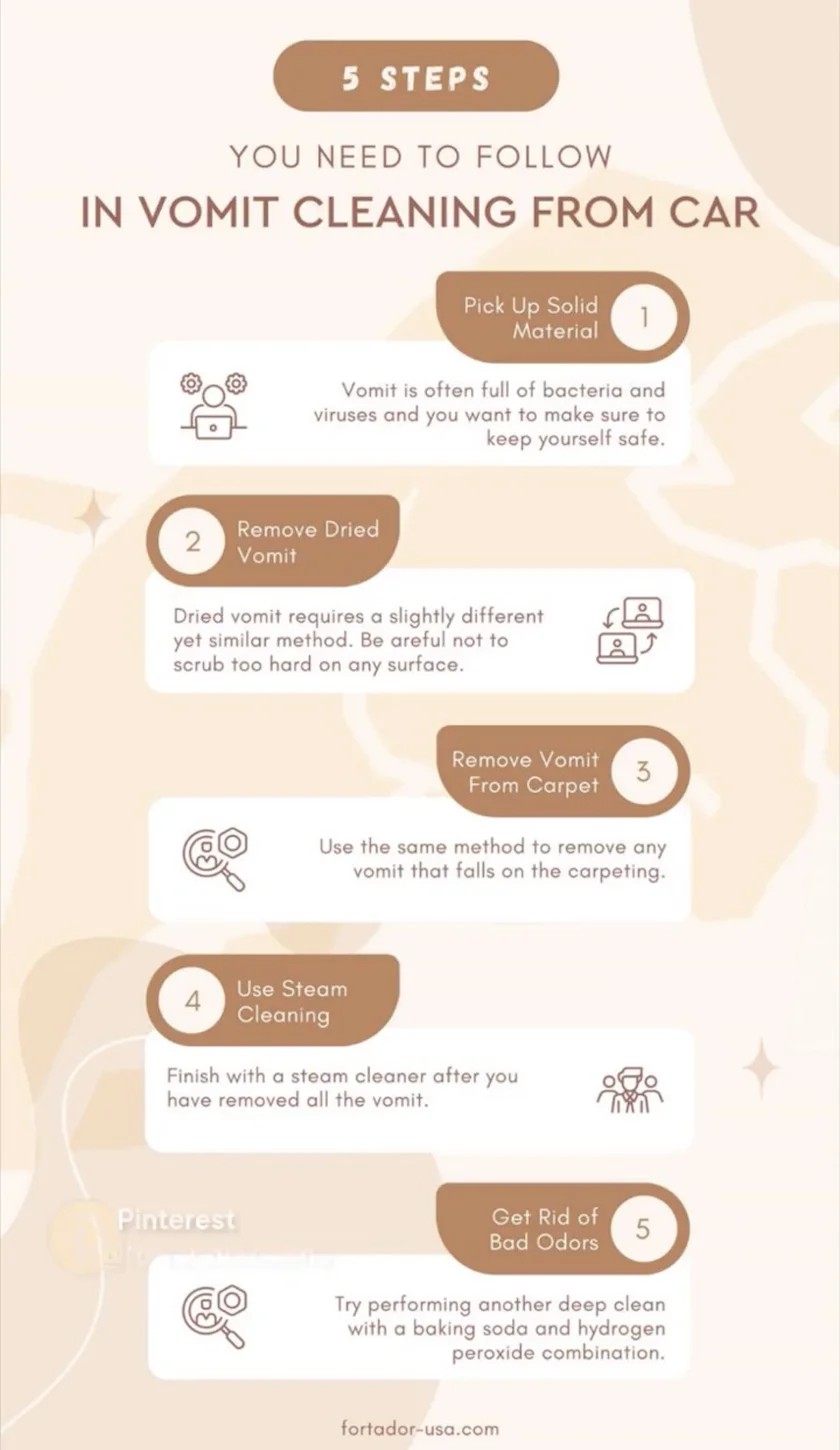
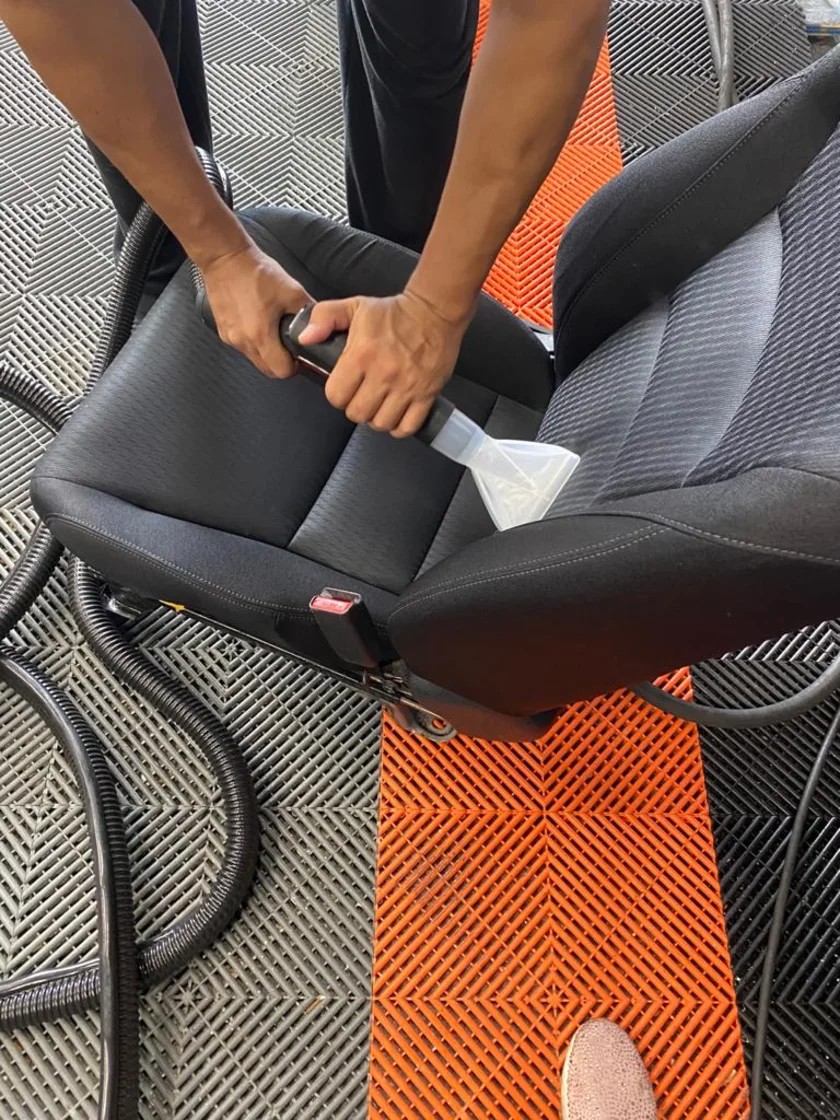

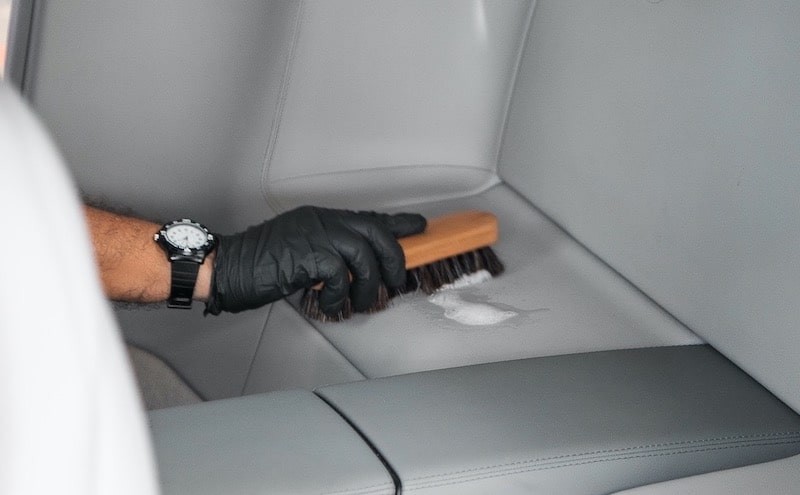
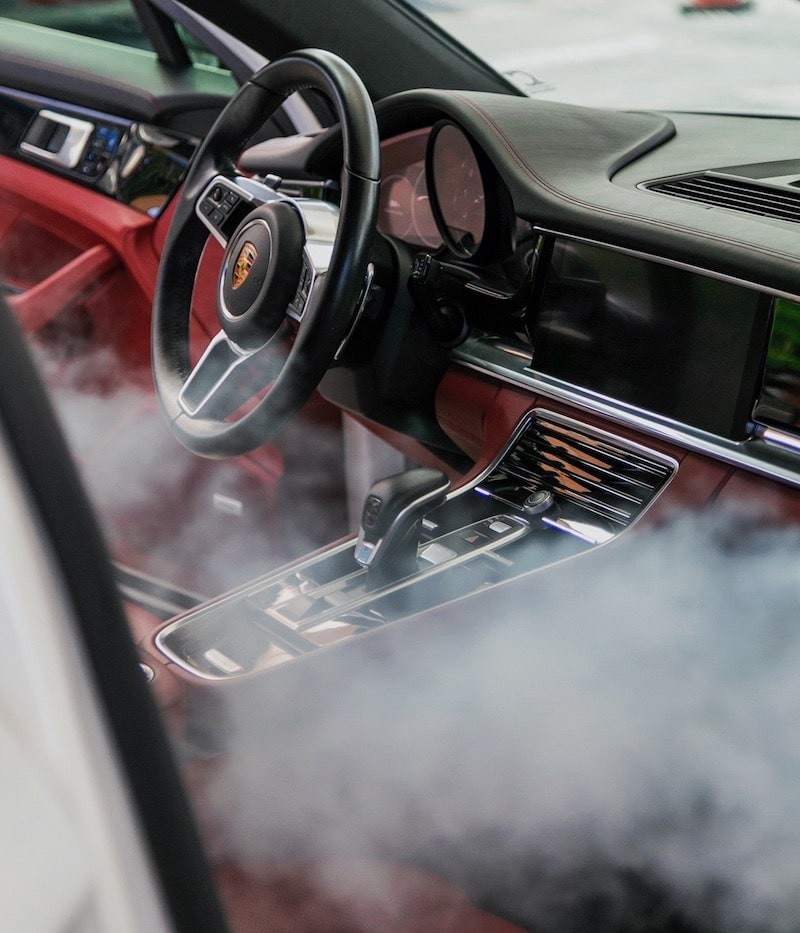
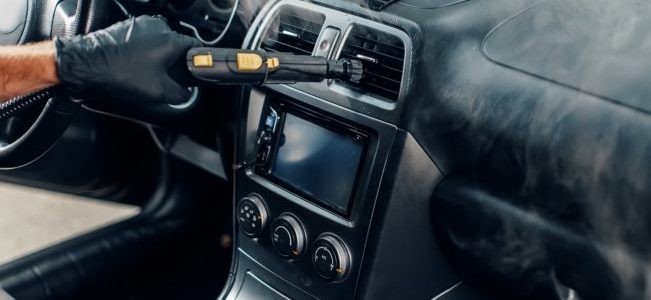
For heavy-duty cleaning, a steam cleaner with a built-in shampooer and extractor can be invaluable. Fortador offers models that combine these functions, streamlining the cleaning process and reducing the need for multiple tools. This all-in-one approach minimizes residue and ensures a thorough clean, keeping your car interior safe for kids and pets.
1.2 Safety First: Essential Protective Measures for Handling Vomit
Cleaning up vomit involves potential exposure to bacteria and viruses, making personal safety a priority.
Personal Protective Equipment (PPE):
- Rubber Gloves: Disposable gloves are essential to prevent direct contact with vomit and potential pathogens.
- Face Mask: A face mask minimizes the risk of inhaling unpleasant odors and airborne particles.
Hygiene Practices:
- Hand Hygiene: Thoroughly wash your hands with soap and warm water for at least 20 seconds after handling vomit or contaminated materials. Use an alcohol-based hand sanitizer (minimum 60% alcohol content) as an alternative.
- Avoid Touching Your Face: Refrain from touching your eyes, nose, and mouth to prevent pathogen transfer.
- Laundering/Disinfecting: Properly launder or disinfect reusable cleaning cloths and gloves before reuse.
2. Tackling Fresh Vomit: A Step-by-Step Guide
Act quickly when dealing with fresh vomit to minimize damage and odor. The sooner you address the mess, the easier it will be to clean.
2.1 Immediate Action: Removing Solid Vomit Debris
Begin by carefully removing any solid material from the affected area.
- Use a spatula, spoon, or layers of paper towels to scrape off solid vomit chunks.
- Be thorough to remove as much solid material as possible.
- Place the waste in a zippered plastic bag or trash bag, along with used paper towels.
- Continue cleaning until all visible solid matter is removed.
Proper Disposal of Contaminated Materials:
- Solid Waste: Carefully remove solid vomit from car seats or carpets using a spatula, spoon, or paper towels. Place the solid waste in a zippered plastic bag or sealed trash bag to prevent leakage.
- Absorbent Materials: Place used paper towels, rags, or cleaning cloths in the sealed bag.
- Double-Bagging: Double-bag the sealed bag for added protection against leaks and odors.
- Disposal: Dispose of the sealed bag in an appropriate waste disposal container, following local guidelines.
2.2 Moisture Control: Blotting Excess Liquid Effectively
After removing solids, address excess moisture to prevent stains and lingering odors.
- Press an absorbent rag or paper towels firmly to absorb liquid without pushing it deeper into the surface.
- Use a wet-dry vacuum or a commercial-grade steamer with extraction to remove smaller chunks and excess liquid.
- Saturate the area with warm water and extract until the water runs clear.
- Repeat the blotting process four to five times to remove all staining liquid.
- Allow rags or paper towels to sit on the surface for at least five minutes to maximize liquid absorption.
2.3 Neutralizing Odors: The Power of Baking Soda
Baking soda is an effective natural deodorizer.
- Sprinkle a thick layer of baking soda over the affected area.
- Let it sit for at least 30 minutes to absorb odors.
- Vacuum up the baking soda, removing the absorbed odors.
2.4 Surface-Specific Cleaning: Vinyl, Cloth, and Plastic Interiors
Different interior surfaces require tailored cleaning approaches. Don’t panic if stains persist initially; persistence is key.
- Cloth Surfaces:
- Mix three drops of dish soap, 1/8 cup of white vinegar, and one cup of warm water in a spray bottle.
- Gently scrub the vomit stains with the mixture.
- Avoid vigorous scrubbing, which can push vomit deeper into the fabric.
- Vinyl Surfaces:
- Vinyl is more durable and can withstand gentle scrubbing.
- Use the same cleaning solution as for cloth surfaces or a dedicated vinyl cleaner.
2.5 Gentle Care: Expert Cleaning for Leather Upholstery
Leather requires a gentle touch to avoid damage.
- Mix one cup of baking soda with 1/3 cup of water to create a paste.
- Apply the paste to the affected area and scrub gently with a dry rag or damp cloth.
- Use a microfiber cloth to blot the area and let it dry.
- A toothbrush can help remove vomit from fabric folds and crevices.
Alternatively, clean leather with a vinegar solution.
- Apply vinegar to a clean rag and carefully wipe the stain.
- Rinse the area with a damp cloth.
- For set-in stains, let the solution sit until it dries, then rewet and scrub gently before removing.
2.6 Final Steps: Rinsing and Drying Techniques
Rinsing and drying are essential to remove cleaning solution residue and prevent moisture buildup.
- Use a damp cloth (leather) or a wet cloth (other surfaces) to wipe down the area.
- Blot with a dry cloth to absorb excess moisture.
- Use a blow dryer to speed up drying, or leave car windows and garage open for natural air circulation.
3. Reviving Your Car: Removing Dried Vomit Stains
Dried vomit stains require a slightly different approach. Patience and persistence are key.
- Wipe or scrape off any dried pieces, using a soft-bristled brush or toothbrush if needed.
- Vacuum up loose pieces.
- Moisten the affected area with a solution of baking soda and warm water or a solution of eight parts water to one part vinegar. Add mild dish soap to the vinegar solution for extra cleaning power.
- Let the solution sit on the stain until it dries, then rewet and let it sit again for several minutes before scrubbing.
- Dip a rag into clean water and blot the affected area, wringing it out frequently.
- Repeat until all cleaning solution and most of the stain are removed.
4. Carpet Care: Vomit Stain Removal on Car Carpets
The same methods for removing vomit from upholstery apply to carpets. You can also try a natural carpet cleaner:
- 1 cup white vinegar
- 2 tablespoons baking soda
- 2 tablespoons fabric softener
- 1/2 tablespoon dish soap
- 10-15 drops of essential oils
Combine these ingredients in a spray bottle, apply to the stains, let sit for a few minutes, and scrub with a brush. Follow the same rinsing procedure as for upholstery.
5. Deep Cleaning Power: Steam Cleaning for Spotless Results
For a thorough cleanup, finish with a steam cleaner after removing all vomit residue. Fortador commercial steamers are highly effective at removing stains, odors, and bacteria. Steam cleaning can also reveal other stains that can be addressed simultaneously.
6. Banishing Lingering Odors: Advanced Techniques
Persistent odors may require extra steps.
6.1 The Deep Clean Method: Baking Soda and Hydrogen Peroxide
Combine one teaspoon of hydrogen peroxide with one cup of baking soda. Let it sit for at least an hour, then remove with a rag and vacuum or steam away the excess.
6.2 Enzymatic Cleaners: Targeting Odor-Causing Bacteria
Natural enzymatic cleaners eliminate odors by killing lingering bacteria. Pour the cleaner directly onto the affected surface and blot dry with an absorbent cloth.
6.3 Air Fresheners: Masking and Eliminating Odors
Air fresheners can help mask lingering odors while other treatments work.
- Hang an air freshener in your car.
- Use a few drops of essential oil (lemon or orange) in a diffuser for a pleasant scent.
6.4 Natural Deodorizers: Absorbing Persistent Odors
Other natural substances can help absorb lingering smells.
- Fill a bowl with activated charcoal, coffee grounds, or white vinegar.
- Leave the bowl in the car overnight, changing it daily until the smell is gone.
- Dampen the dirty spot with water, sprinkle with an essential oil and baking soda mixture, let sit for ten minutes, and vacuum.
- Place dryer sheets on top of the stain and cover with coffee grounds.
6.5 Ventilation: The Power of Fresh Air
Keep car windows open as much as possible before, during, and after cleaning to dissipate odors.
6.6 Enzyme-Based Cleaners: A Targeted Approach to Odor Elimination
An enzyme-based cleaner is a highly effective solution for eliminating stubborn odors. These cleaners break down the organic matter and bacteria that cause unpleasant smells, leaving your car interior fresh and clean.
7. Conclusion: Maintaining a Fresh and Clean Vehicle
Cleaning vomit from your car demands prompt action, the right tools, and effective techniques. By following the steps in this guide, you can effectively remove stains and odors. Remember to use personal protective equipment and properly dispose of contaminated materials. Ventilate your car to allow fresh air to circulate and eliminate lingering odors.
Do Not Forget to Ventilate
Proper ventilation is key to removing odors and ensuring a fresh and clean car interior.
Expert Solutions at CARS.EDU.VN
At CARS.EDU.VN, we understand the challenges of maintaining a clean and fresh-smelling car. That’s why we provide in-depth guides, expert advice, and connections to trusted service providers. Whether you’re dealing with vomit, spills, or stubborn odors, we’re here to help.
Need Professional Help?
Visit CARS.EDU.VN to find local detailing services specializing in interior cleaning and odor removal. Our directory features reputable businesses with the expertise and equipment to restore your car to its pristine condition.
Contact Us:
- Address: 456 Auto Drive, Anytown, CA 90210, United States
- WhatsApp: +1 555-123-4567
- Website: CARS.EDU.VN
Let CARS.EDU.VN be your go-to resource for all your car care needs. We’re dedicated to providing the information and services you need to keep your vehicle looking and smelling its best.
FAQ: Addressing Common Questions About Vomit Cleanup in Cars
Here are some frequently asked questions about cleaning vomit from your car:
-
What’s the first thing I should do when someone vomits in my car?
- Act quickly! Remove solid matter and blot up excess liquid immediately to minimize staining and odor.
-
Can I use regular household cleaners to clean vomit in my car?
- While some household cleaners may work, it’s best to use products specifically designed for car interiors to avoid damage.
-
How do I get the vomit smell out of my car?
- Baking soda, enzymatic cleaners, and thorough ventilation are effective at removing vomit odors.
-
Is it safe to use bleach to clean vomit in my car?
- Bleach can damage car interiors. It’s best to use safer alternatives like vinegar or hydrogen peroxide.
-
What if I can’t remove the vomit stain completely?
- Consider professional detailing services for stubborn stains.
-
How long does it take for the vomit smell to disappear from my car?
- With thorough cleaning and ventilation, the smell should dissipate within a few days.
-
Can vomit damage my car’s interior?
- Yes, vomit is acidic and can damage surfaces if not cleaned promptly.
-
What’s the best way to clean vomit from leather seats?
- Use a gentle leather cleaner and avoid harsh scrubbing to prevent damage.
-
Should I wear gloves and a mask when cleaning vomit?
- Yes, wearing gloves and a mask protects you from bacteria and odors.
-
Where can I find professional help for cleaning vomit in my car?
- Visit cars.edu.vn to find reputable detailing services in your area.
